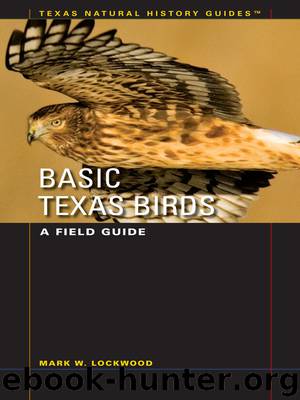Basic Texas Birds by Mark W. Lockwood

Author:Mark W. Lockwood
Language: eng
Format: epub
Tags: -
Publisher: University of Texas Press
Published: 2014-11-10T16:00:00+00:00
Golden-fronted Woodpecker, male. Photo by Tim Cooper.
YELLOW-BELLIED SAPSUCKER
Sphyrapicus varius
BACKGROUND Yellow-bellied Sapsuckers and the other species in the genus are well known for drilling rows of relatively shallow holes in trees for harvesting sap (thus the name “sapsucker”). They drill two basic types of holes: round, deeper holes are made specifically to probe for sap, and shallower holes maintain a continuous flow of sap at the surface.
IDENTIFICATION Yellow-bellied Sapsuckers are medium-sized woodpeckers. Adult males have a prominent red cap and throat. The throat patch is bordered by black, which extends into a bib on the upper breast. The remainder of the head is also largely black with two bold white lines. One line starts at the base of the bill and goes below the eye, and the other is a postocular stripe. The upperparts are mottled brown and white with black wings. The wings have a conspicuous white shoulder patch visible on the perched bird as well as in flight. The rump is white and obvious in flight. The underparts are yellowish with heavy barring on the flanks. The female is similar to the male except that she has a white chin, and some have a reduced crown patch. Immature birds are brownish with a muted pattern of the adults.
SIMILAR SPECIES The Red-naped Sapsucker (S. nuchalis) is similar in all plumages. The adult has a red spot in the white stripe across the back of the head, but this can be inconspicuous, and a few Yellow-bellied Sapsuckers have a similar feature. A more consistent field mark is the more extensive red throat in males that blends in to the black outline. The Red-naped also has less white on the back, and the white is restricted to two strips. The female Red-naped has a red throat with a contrasting white chin. Immature birds can be difficult (and in some cases in early fall impossible) to separate. By early winter the plumage pattern of the adult starts to develop, and these birds can usually be identified.
HABITAT A wide variety of woodland habitats in winter. Most common in open woodlands, including in urban settings.
STATUS AND DISTRIBUTION Uncommon to locally common migrant and winter resident throughout most of the state. Rare in the western third of the Trans-Pecos. Fall migrants begin arriving in Texas in early October and are present through March, with a few lingering into April. There are even a few records of individuals staying as late as early May.
Download
This site does not store any files on its server. We only index and link to content provided by other sites. Please contact the content providers to delete copyright contents if any and email us, we'll remove relevant links or contents immediately.
| Amphibians | Animal Behavior & Communication |
| Animal Psychology | Ichthyology |
| Invertebrates | Mammals |
| Ornithology | Primatology |
| Reptiles |
Sapiens: A Brief History of Humankind by Yuval Noah Harari(13119)
The Tidewater Tales by John Barth(12045)
Do No Harm Stories of Life, Death and Brain Surgery by Henry Marsh(6349)
Mastermind: How to Think Like Sherlock Holmes by Maria Konnikova(6272)
The Thirst by Nesbo Jo(5819)
Why We Sleep: Unlocking the Power of Sleep and Dreams by Matthew Walker(5678)
Sapiens by Yuval Noah Harari(4575)
Life 3.0: Being Human in the Age of Artificial Intelligence by Tegmark Max(4536)
The Longevity Diet by Valter Longo(4464)
The Rules Do Not Apply by Ariel Levy(3935)
The Body: A Guide for Occupants by Bill Bryson(3855)
The Immortal Life of Henrietta Lacks by Rebecca Skloot(3841)
Why We Sleep by Matthew Walker(3797)
Animal Frequency by Melissa Alvarez(3770)
Yoga Anatomy by Kaminoff Leslie(3724)
Barron's AP Biology by Goldberg M.S. Deborah T(3643)
The Hacking of the American Mind by Robert H. Lustig(3599)
All Creatures Great and Small by James Herriot(3541)
Yoga Anatomy by Leslie Kaminoff & Amy Matthews(3419)
